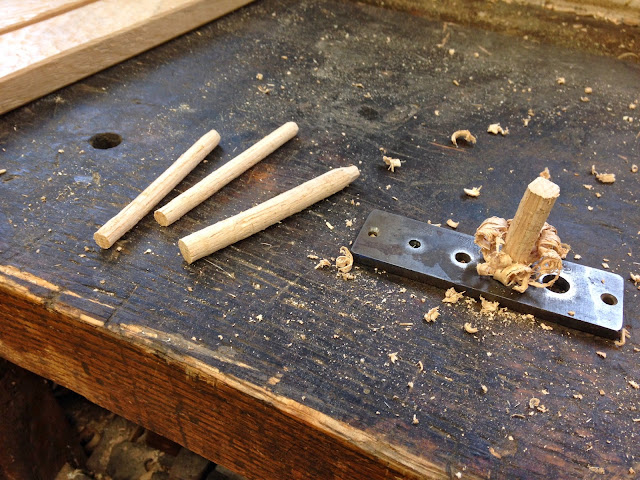Leave it to the 17th century to vernacularize (new word?) thatching tools. During my research of what we needed to thatch one of the houses in the village I first found that a biddle was a thatching ladder that hooks into the roof. This was all well and good...that was until I found that certain groups of people also called the paddle used for beating the thatch a biddle. Most of you will know this tool as a Legget, if you know it at all. Further still I have seen one source referring to this paddle as a Dutchman, referring to the Netherlandic (another new word?) pattern used.
This is half the problem doing research on work-ways in the period. Everyone calls similar items by different names, and even worse, different items by similar names. If that isn't enough, even when you know the name for something you might not spell it the same as they did back in the day.
For instance, I have seen these thatching paddles called: paddles, battles, liggets, dressers, baddles, biddles, leggets, beetles, bats, and...yes...even Dutchman. On a side note, beetles are also large wooden mallets used for splitting pale and persuading timbers, leading to an even more convoluted set of tool terms.
This is all academic minutiae of coarse and the only thing that matters is that leggets are very real things, even if they do exist in two places at one time. On to the build!
To start off, I found a white oak crook with just the right proportions and angles. Five minutes at the shaving mare and I had a very respectable looking handle. I also took a nice clear pine log (possibly Eastern White, but I can't be sure) and split it up to make a rough bolt. Five more minutes with a hatchet and I had a reasonably flat and square hewn board. Good enough for me!
 |
| The blank pieces before any joinery. Saw, hatchet, and draw knife. |
The geometry of a legget is pretty simple, step off the board into equal segments, scribe parallel lines, and then mark the end grain with 45 degree angles. Next it was as simple as letting in the lines with a rip saw and paring the waste using a sharp chisel. I used a flat sided firmer chisel just to see if I could use the tools a farmer-carpenter might have available, but a bevel edged paring chisel would have made the whole thing a breeze.
 |
| Half way done, using my new carpenters bench...but that is a different story |
After establishing the ribs on the front, I flipped the board over and scribed the handle onto the back to make a socket. This is real rough work...but also real precise work. It needs to fit as snug as possible so it stays tight after lots of abuse, but it is a tricky irregular notch, so there is room for some wiggle, I just used my judgement and a small 3/4" chisel.
 |
| The X was scribed on the back to find the center. The handle was placed by eye. |
Finally was clenching the paddle onto the handle. I have the distinct advantage of working with two great blacksmiths, so I had hand made wrought iron nails to use. If you wanted to do something like this, or have another project in mind, the museum's blacksmith Mattheo does some great commission work, so check out his
shop!
 |
| The handle and paddle joined. |
I used four long nails that I clenched in alternating directions which will hopefully lend strength to the connection. The fifth nail was driven at a slight angle into the handle. Don't ask me why I did this...it just seemed like a good idea at the time.
 |
| Some selective carving was done to allow for flat faces for the nail heads. |
We only have two sizes of wimble and bits at the museum, nail and spike. Turns out the nail bit is slightly larger than the nails, as it should be when installing pale and clapboards, but it was a little looser than I would have liked on this project. Luckily I alternated the holes, and these wrought iron nails are great for clenching, so I feel like I got a nice strong connection.
 |
| This tool has a simplistic beauty that is unmistakable. |
By May this legget should have one thatched roof and several cap repairs under its belt, so I will have to give a status report then. Overall I am really happy with the result, it feels super stable, has a great sweep to the handle, and is probably the most work-manly thing I have made to date. Total build time was about 4 hours from log to legget.
 |
| Did the settlers care about ergonomics, because this legget has it in spades! |






































